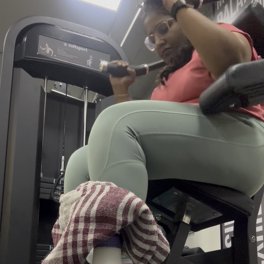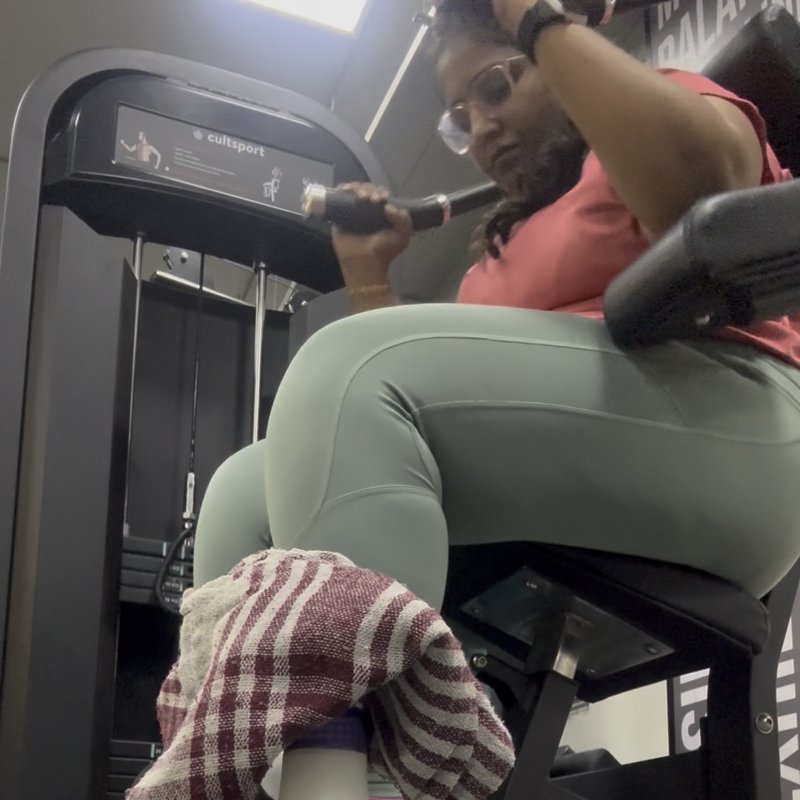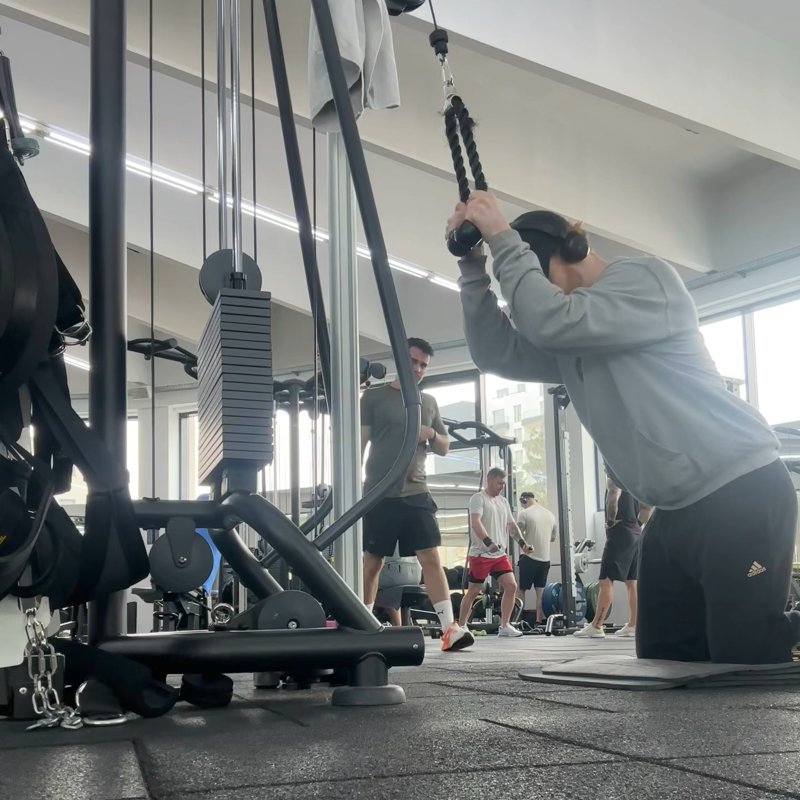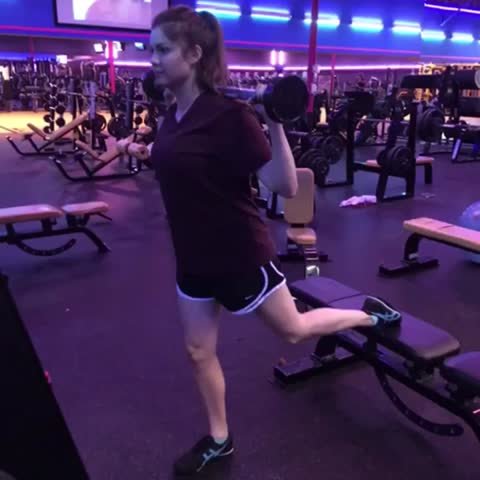Abdominal Crunch Machine: The Ultimate Guide
The Abdominal Crunch Machine is a guided resistance exercise that targets the rectus abdominis and obliques by flexing the torso against weighted resistance along a fixed movement path.

Quick Facts
Key Benefit
Targeted abdominal development with progressive loading
Primary Muscles
Obliques
Secondary Muscles
Erector Spinae, Hip Flexors, Pectoralis Minor
Equipment
machine
Difficulty
Beginner
Type
Strength
In This Guide
Ready to master the Abdominal Crunch Machine?
Track your progress, see improvements over time, and build strength consistently.
Download GravitusThe Abdominal Crunch Machine provides a structured approach to core training, offering unique advantages that complement traditional bodyweight exercises in a comprehensive abdominal development program. This specialized equipment guides your movement through a fixed path while allowing for incremental resistance progression, creating an environment for targeted abdominal development. What makes the machine variation particularly valuable is its accessibility across fitness levels. The guided movement pattern simplifies the exercise, allowing beginners to learn proper abdominal contraction patterns while providing advanced lifters the ability to progressively overload their core muscles—something that can be challenging with bodyweight exercises alone. Additionally, the machine's design typically features padded support for the back and arms, potentially reducing strain on the neck and shoulders that can occur during floor-based crunches when performed with improper form. This allows for greater focus on the target muscles without unnecessary stress on supporting structures. While bodyweight core exercises remain fundamental, the Abdominal Crunch Machine offers valuable variety in resistance type, allowing for concentrated abdominal work with precise control over load and form. Whether you're a beginner learning proper core engagement, an intermediate lifter adding isolated volume to your program, or an advanced athlete seeking to challenge your abs with substantial resistance, this machine provides an effective addition to your core training arsenal.
Benefits of Abdominal Crunch Machine
The Abdominal Crunch Machine offers several distinct advantages that make it a valuable addition to your core training routine.
Progressive Resistance
Allows for systematic loading of the abdominal muscles beyond what's possible with many bodyweight variations, enabling continued strength development.
Reduced Technical Demand
The guided motion simplifies the exercise, helping beginners establish proper movement patterns while allowing more advanced lifters to focus solely on intensity.
Targeted Activation
The fixed movement path helps isolate the abdominal muscles, potentially reducing unwanted involvement from hip flexors that often occurs in floor-based exercises.
Neck and Shoulder Relief
Most machines provide padded support for the upper body, reducing the neck and shoulder strain commonly experienced during improperly performed floor crunches.
Precise Control
The systematic nature of machine training—with consistent resistance throughout the range of motion—makes controlling intensity and tracking progress straightforward.
Proper Form & Technique
Setup
- Adjust the seat height so that when seated, the movement arm pads align with your shoulders or chest (depending on machine design).
- Sit with your back against the back pad, maintaining natural spinal curves.
- Position your feet flat on the floor or on any foot platforms, approximately shoulder-width apart.
- Grasp the handles or place your hands on the designated arm pads, depending on the machine design.
- If the machine has a seatbelt or lap restraint, secure it comfortably across your thighs.
- Ensure your head is in a neutral position, aligned with your spine rather than jutting forward.
- Take a moment to find your optimal position where you feel the emphasis on your abdominals rather than your neck or lower back.
- Adjust the weight selector pin to an appropriate resistance for your strength level.
Movement
- Take a deep breath and engage your core muscles, drawing your navel slightly toward your spine.
- Initiate the movement by flexing your trunk forward, contracting your abdominal muscles.
- Move through a controlled range of motion, bringing your chest or shoulders toward your pelvis.
- Focus on creating the movement through spinal flexion rather than hip flexion.
- Continue the forward flexion until you feel a strong contraction in your abdominal muscles.
- Hold the contracted position briefly, focusing on the tension in your abdominals.
- Slowly return to the starting position with control, maintaining tension in your core.
- Avoid letting the weight stack touch down between repetitions to maintain constant tension.
- Exhale during the contraction phase and inhale during the return phase.
- Repeat for the desired number of repetitions, maintaining quality movement throughout.
Key Form Tips
Abdominal Focus
Concentrate on feeling your abdominal muscles contract rather than simply moving the weight, enhancing mind-muscle connection.
Range of Motion
Use a range that allows for complete contraction without straining your neck or lower back—quality of movement trumps quantity.
Breathing Pattern
Coordinate your breathing with the movement, exhaling during the contraction phase to help maintain proper core engagement.
Speed Control
Move at a controlled tempo throughout the exercise, avoiding rapid or jerky movements that reduce muscle tension and increase injury risk.
Full Extension
Return to the starting position with control but avoid excessive arching or hyperextension of the lower back at the end range.
Muscles Worked
Primary Muscles
- Rectus Abdominis: The paired muscles running vertically along the front of the abdomen, primarily responsible for spinal flexion and often referred to as the "six-pack" muscles.
- obliques: The external and internal oblique muscles on the sides of the torso that assist with spinal flexion and rotation.
Secondary Muscles
- Transverse Abdominis: The deepest abdominal muscle layer that acts like a corset, providing stability and compression to the abdominal cavity.
- pectoralis minor: The finger-like muscles along the ribs that assist with scapular movement during the forward flexion.
- Hip Flexors: While not the target muscles, the iliopsoas and rectus femoris may engage to a minor degree during the movement, particularly if form is not optimal.
- erector spinae: Work eccentrically during the contraction phase and concentrically during the return to control movement and maintain stability.
Common Mistakes and How to Fix Them
Using Momentum
Relying on jerky movements or momentum rather than controlled muscle contraction to move the weight. Focus on a slow, deliberate tempo for each repetition (e.g., 2 seconds to contract, 1-second pause, 3 seconds to return). Consider temporarily reducing the weight until proper control can be maintained throughout the set. Concentrate on feeling the abdominal muscles work rather than simply completing repetitions.
Hip Flexor Dominance
Allowing the hip flexors to take over the movement, reducing abdominal engagement and potentially creating lower back discomfort. Initiate the movement by drawing your ribcage toward your pelvis rather than bringing your shoulders forward, emphasizing spinal flexion over hip flexion. Throughout the movement, focus on curling your torso rather than lifting your upper body as a single unit. If hip flexor dominance persists, check your seat position and ensure proper machine adjustment for your body proportions.
Excessive Range of Motion
Forcing the movement beyond a natural range, which can place unnecessary stress on the neck and lower back. Find the range that allows for maximum abdominal contraction without strain on other structures. Avoid the urge to "chase" a specific position or degree of flexion, instead focusing on the quality of muscular contraction. Listen to your body's feedback - if you feel strain in areas other than your abdominals, reduce your range of motion.
Holding Breath
Failing to maintain proper breathing patterns, which can increase blood pressure and reduce core stability. Establish a consistent breathing rhythm—typically exhaling during the contraction phase and inhaling during the return. Avoid breath-holding (Valsalva maneuver) unless specifically trained in this technique for performance purposes. If you find yourself naturally holding your breath, consciously focus on breathing for several repetitions until the pattern becomes more automatic.
Pulling with Arms or Shoulders
Using arm strength to pull the pads forward rather than creating the movement through abdominal contraction. Place your hands lightly on the handles or pads without gripping tightly, using them primarily for stability rather than active pulling. Focus on your arms as passive connections rather than primary movers. If necessary, occasionally perform a set with hands placed across your chest (if the machine design allows) to reinforce proper movement patterns.
Abdominal Crunch Machine Variations
Equipment Variations
-

Seated Crunch Machine
The most common variation where you're seated upright with pads that move forward as you contract your abs against resistance.
-

Rotary Torso Machine
A seated machine that targets the obliques through rotational movement against resistance.
-

Kneeling Ab Crunch Machine
Performed from a kneeling position with pads that move downward as you contract your abs.
-
Cable Crunch
Not technically a machine but offers similar benefits with a cable apparatus, allowing for greater variety in positioning and angle of resistance.
Technical Variations
-
Weighted Decline Crunch
Using a decline bench with additional resistance from a weight plate or medicine ball, providing a middle ground between machine and bodyweight training.
-

Abdominal Machine with Rotation
Incorporating a slight rotational component during the crunch to increase oblique engagement, if the machine design allows.
-

Isometric Hold Crunch
Holding the contracted position for an extended period (5-15 seconds) to increase time under tension and abdominal endurance.
-

Pulse Crunch
Using small, pulsing partial repetitions in the contracted position to increase time under tension and muscle fatigue.
Frequently Asked Questions
Neither variation is inherently "better"—each offers distinct advantages that can make them valuable components of a complete core training program. Machine crunches excel at providing progressive resistance beyond bodyweight, allowing for continued strength development once basic abdominal strength is established. The guided motion often reduces strain on the neck and shoulders that can occur with improperly performed floor crunches. The fixed movement path can enhance isolation of the target muscles for beginners learning proper engagement patterns. Floor crunches require no equipment, making them accessible anywhere. They develop proprioception and body awareness more effectively than machine variations. As a bodyweight exercise, they allow for numerous variations to target different aspects of the core. From a practical standpoint, combining both approaches often yields optimal results. Consider using machine crunches when targeting pure strength development or when seeking to add resistance beyond bodyweight. Floor crunches and their variations might be emphasized for skill development, as warm-up movements, or when equipment access is limited. The ideal approach depends on your specific goals, training history, and preferences. For most trainees, incorporating both machine and bodyweight core training provides complementary benefits and prevents adaptation plateaus.
The optimal repetition range depends on your specific goals, current fitness level, and the amount of resistance used. For strength development, working in the 8-12 repetition range with challenging resistance can be effective. This approach focuses on building raw abdominal strength and can contribute to muscle development, though visible abs ultimately depend more on body fat levels than muscle size. For muscle endurance and conditioning, higher repetition ranges of 15-25 reps per set might be more appropriate. This approach can improve the core's ability to sustain contraction over time, which can benefit performance in many activities. The abdominal muscles contain a mix of fast and slow-twitch fibers, with a tendency toward higher endurance capacity than many other muscle groups. This makes them responsive to both moderate and higher rep ranges. For optimal development, many successful programs incorporate periodized training with some phases emphasizing lower reps with heavier weight and others focusing on higher reps with moderate resistance. Regardless of the rep range selected, maintain quality movement throughout—once form begins to deteriorate, the set should typically be terminated. When beginning with the machine, err on the side of higher repetitions (12-15) with moderate weight to develop proper form and movement patterns before potentially progressing to heavier loading with lower repetitions.
Abdominal training frequency depends on several factors including your overall program structure, recovery capacity, training goals, and the intensity of your sessions. The abdominal muscles recover relatively quickly compared to larger muscle groups, making them capable of more frequent training for most individuals. For most recreational exercisers, training abs directly 2-3 times per week provides sufficient stimulus while allowing adequate recovery between sessions. This frequency works well when using moderate to high intensity on the abdominal crunch machine. For those with specific core development goals, training frequency might increase to 3-4 times weekly, potentially with varied approaches (e.g., strength-focused machine work on some days, endurance-oriented bodyweight exercises on others). Remember that the core musculature also receives indirect work during many compound exercises like squats, deadlifts, and overhead presses. This indirect volume should be considered when planning direct abdominal training frequency. Pay attention to recovery signals—if you experience persistent soreness or decreased performance, you may need to reduce frequency temporarily. For beginners, starting with 2 weekly sessions and gradually increasing based on recovery and progress is a prudent approach. Advanced trainees might benefit from periodizing their abdominal training across a training cycle, with periods of higher frequency (4-5 times weekly) during specialization phases followed by lower frequency maintenance periods.
Visible abdominal definition primarily depends on body fat percentage rather than abdominal muscle size or strength. Even the strongest, most developed abs will remain hidden beneath a layer of subcutaneous fat. For most individuals, abs become increasingly visible as they reach lower body fat percentages—typically below approximately 15% for men and 22% for women, though this varies significantly between individuals based on genetics and fat distribution patterns.
Training the abdominal muscles using the crunch machine or other exercises is important for developing their size and strength, but this development alone won't make them visible without appropriate body composition. Nutrition plays the central role in reducing body fat to levels where abdominal definition becomes apparent. Creating a modest caloric deficit through a combination of dietary modification and increased energy expenditure is the primary approach to reducing overall body fat percentage.
Importantly, spot reduction (losing fat specifically from the abdominal area through targeted exercise) has been repeatedly shown to be ineffective. Fat loss occurs systemically throughout the body in a genetically predetermined pattern. For comprehensive results, consider a three-pronged approach - 1. Direct abdominal training using progressive resistance to develop the muscles 2. Compound exercises that burn significant calories while indirectly engaging the core 3. Nutrition strategies that support overall fat loss while preserving muscle mass
Patience is essential—visible abs represent a relatively advanced level of leanness that requires consistent effort over time.
Video Demonstrations

Log in to watch video demonstrations
Login to Watch2 video demonstrations available
Tips from the Community
-

Str was
-

Slow and controlled movements
Track your progress with Gravitus
Download Gravitus to log your workouts, track your progress, and join a community of fitness enthusiasts.

Helpful Resources
One Rep Max Calculator
Find your one rep max for any exercise without maximal testing. Essential for developing effective strength training programs.
Calculate 1RMWorkout Programs
Follow structured workout programs created by fitness professionals to maximize your strength and muscle gains.
View Programs




